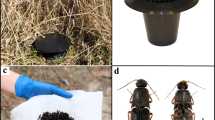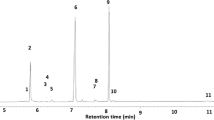Abstract
A single sex pherormone component was isolated from abdominal tip extracts of female Bruce spanworm.Operophtera bruceata (Hulst). This was identified as (Z,Z,Z)-1,3,6,9-nonadecatetraene by capillary gas chromatography (GC), electroantennography, and mass spectrometry. In addition, hexane extracts of female abdominal tips from Bruce spanworm and the winter moth.O. brumata L., were analyzed by GC coupled to an electroantennographic detector (GC-EAD). The extracts ofO. bruceata andO. brumata females elicited only a single response, at the same retention time, from antennae of their conspecific and reciprocal males. In field tests conducted in Saskatchewan, traps baited with the synthetic tetraene captured Bruce spanworm males. In tests carried out on Vancouver Island, British Columbia, where the two species coexist, both Bruce spanworm and winter moth males were captured. The attractancy of lures containing the synthetic pheromone alone and in combination with several structurally related analogs was field tested at both locations. One of these, an isomer of the natural pheromone, (E,Z,Z)-1,3,6,9-nonadecatetraene, inhibited the capture of Bruce spanworm males but had no effect upon the number of winter moth males which were taken. Thus, populations of these two very similar species can be distinguished by employing traps baited with pheromone ± the inhibitor. Coneorifice Hara traps were found useful for field trapping males of both species.
Similar content being viewed by others
References
Arn, H., Städler, E., andRauscher, S. 1975. The electroantennographic detector—a selective and sensitive tool in the gas Chromatographic analysis of insect pheromones.Z. Naturforsch. 30c:722–725.
Bestmann, H.J., Brosche, T., Koschatzky, K.H., Michaelis, K., Platz, H., Roth, K., andVostrowsky, O. 1982. 1,3,6,9-Nonadecatetraen, das Sexualpheromon des FrostspannersOperophtera brumata (Geometridae).Tetrahedron Lett. 23:4007–4010.
Brown, C.E., 1962. The life history and dispersal of the Bruce spanworm,Operophtera bruceata (Hulst), (Lepidoptera: Geometridae).Can. Entomol. 94:1103–1107.
Corey, E.J., andSuggs, J.W. 1975. Pyridinium chlorochromate. An effective reagent for oxidation of primary and secondary alcohols to carbonyl compoundsTetrahedron 31:2647–2650.
Duncan, D.B. 1955. Multiple range and multiple F tests.Biometrics 11:1–41.
Eidt, D.C., Embree, D.G., andSmith, C.C. 1966. Distinguishing adults of the winter mothOperophtera brumata (L.), and Bruce spanwormO. bruceata (Hulst) (Lepidoptera: Geometridae).Can. Entomol. 98:258–261.
Embree, D.G. 1965. The population dynamics of the winter moth in Nova Scotia, 1954–1962.Mem. Entomol. Soc. Can. 46:57 pp.
Gillespie, D.R., Finlayson, T., Tonks, N.V., andRoss, D.A. 1978. Occurrence of the winter moth,Operophtera brumata (Lepidoptera: Geometridae), on southern Vancouver Island, British Columbia.Can. Entomol. 110:223–224.
Huang, W., Pulaski, S.P., andMeinwald, J. 1983. Synthesis of highly unsaturated insect pheromones: (Z,Z,Z)-1,3,6,9-Heneicosatetraene and (Z,Z,Z)-1,3,6,9-nonadecatetraene.J. Org. Chem. 48:2270–2274.
Jain, S.C., Roelofs, W.L., andMeinwald, J. 1983. Synthesis of a sex attractant pheromone from a geometrid moth,Operophtera brumata (the winter moth),J. Org. Chem. 48:2274–2275.
Knauf, W., Bestmann, H.J., andVostrowsky, O. 1984. Responses of male winter moths (Operophtera brumata) to their sex attractant (3Z,6Z,9Z)-1,3,6,9-nonadecatetraene and to some structural analogues.Entomol. Exp. Appl. 35:208–210.
Millar, J.G., andUnderhill, E.W. 1986. Short synthesis of 1,3Z,6Z,9Z-tetraene hydrocarbons, lepidopteran sex attractants.Can. J. Chem. 64:2427–2430.
Roelofs, W.L., Hill, A.S., Linn, C.E., Meinwald, J., Jain, S.C., Herbert, H.J., andSmith, R.F. 1982. Sex pheromone of the winter moth, a geometrid with unusually low temperature precopulatory responses.Science 217:657–659.
Steck, W., andBailey, B.K. 1978. Pheromone traps for moths: Evaluation of cone trap designs and design parameters.Environ. Entomol. 7:449–455.
Stoakley, J.T. 1985. Outbreaks of winter moth,Operophtera brumata L. (Lepidoptera: Geometridae) in young plantations of Sitka spruce in Scotland.Z. Angew. Entomol. 99:153–160.
Underhill, E.W., Palaniswamy, P., Abrams, S.R., Bailey, B.K., Steck, W.F., andChisholm, M.D. 1983. Triunsaturated hydrocarbons, sex pheromone components ofCaenurgina erechtea.J. Chem. Ecol. 9:1413–1423.
Wong, J.W., Palaniswamy, P., Underhill, E.W., Steck, W.F., andChisholm, M.D. 1984a. Novel sex pheromone components from the fall cankerworm moth,Alsophila pometaria.J. Chem. Ecol. 10:463–473.
Wong, J.W., Palaniswamy, P., Underhill, E.W., Steck, W.F., andChisholm, M.D. 1984b. Sex pheromone components of fall cankerworm moth,Alsophila pomentaria. Synthesis and field trappingJ. Chem. Ecol. 10:1579–1596.
Wong, J.W., Underhill, E.W., MacKenzie, S.L. andChisholm, M.D. 1985. Sex attractants for geometrid and noctuid moths. Field trapping and electroantennographic responses to triene hydrocarbons and monoepoxydiene derivatives.J. Chem. Ecol. 11:727–756.
Author information
Authors and Affiliations
Additional information
Issued as NRCC No. 26107
Rights and permissions
About this article
Cite this article
Underhill, E.W., Millar, J.G., Ring, R.A. et al. Use of a sex attractant and an inhibitor for monitoring winter moth and bruce spanworm populations. J Chem Ecol 13, 1319–1330 (1987). https://doi.org/10.1007/BF01012279
Received:
Accepted:
Issue Date:
DOI: https://doi.org/10.1007/BF01012279




